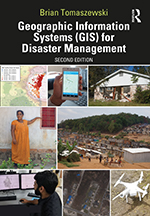
|
Chapter 9: Geographic Information Systems and Disaster Mitigation |
This is the companion website for Chapter 9: Geographic Information Systems and Disaster Mitigation from the book Geographic Information Systems (GIS) for Disaster Management (second edition). This page contains links to any technical video walk throughs contained in the chapter, slides for the chapter, chapter test questions, and other additional materials.
Chapter Abstract
This chapter presents the concept of geographic information systems (GIS) for disaster mitigation. The chapter first situates mitigation within the ideas risk, vulnerability, and resilience intertwined within the subtleties of geographic contexts. Disaster mitigation policy and GIS perspectives are next discussed via the US National Mitigation Framework which defines seven core capabilities for community reducing risk reduction and resilience. The United Nations Offer for Disaster Risk Reduction is also discussed for a global perspective. GIS techniques for disaster mitigation follow via topics such as modeling risk and vulnerability via social (i.e., age, gender, education level) and physical (i.e., slope, building material) variables and where to find data on such variables such as the US Census Bureau website as well as United States Geological Survey (USGS). An overview of how to develop the spatial index of vulnerability using Weighted Overlay techniques is presented. The concept of developing a spatial index of vulnerability is further expanded upon at the chapter’s conclusion via an extensive technical exercise on creating a displacement natural disaster resilience index using ArcGIS Pro and QGIS.
Chapter Objectives: Upon chapter completion, readers should be able to:
- appreciate the particularly interdisciplinary nature of disaster mitigation and geographic information systems (GIS);
- have a basic understanding of the concepts of vulnerability and resilience and how they relate to GIS;
- understand the basics of disaster-mitigation policy and how GIS is relevant to that policy;
- be familiar with international organizations focused on disaster mitigation;
- have a basic understanding of different social and physical spatial variables that can be used in GIS to model risk, vulnerability, and resilience;
- understand basic approaches for developing vulnerability, risk, and resilience indexes using different types of spatial variables.
Follow these links to access Chapter 9: Geographic Information Systems and Disaster Mitigation materials:
- Chapter 9 Slides (.pptx, 1.2 mb)
- Exercise 9-1: Creating a Displacement Natural Disaster Resilience Index video walkthrough
- Chapter 9 Test Bank (.docx, 20 kb) | Chapter 9 Test Bank (.pdf, 147 kb)
For information on this chapter, purchase the book from Routledge Press »